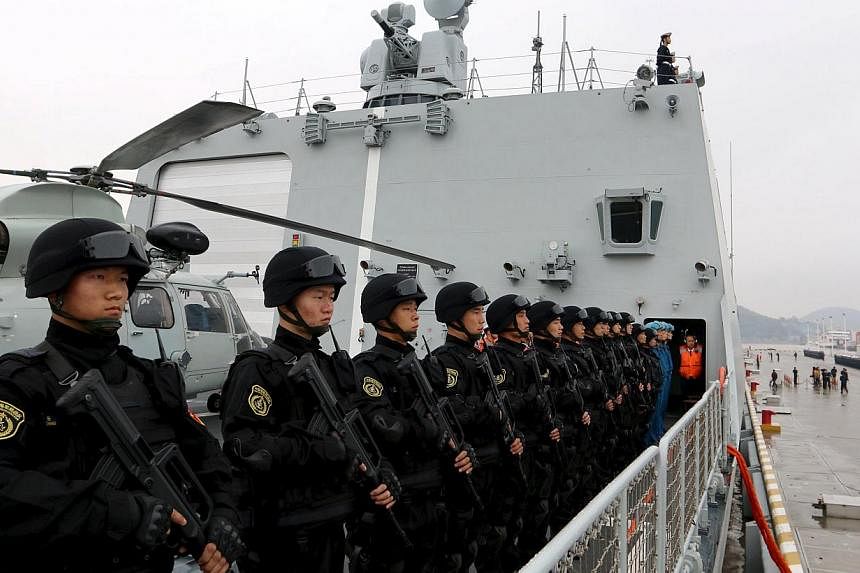Transparency and ambition
CHINA issued China's Military Strategy, a defence White Paper, on Tuesday. This paper, along with The Diversified Employment of China's Armed Forces published in 2013, are hugely different from the previous China's National Defence papers, as they are thematic defence White Papers. They represent China's latest move in military transparency in two critical areas - capabilities and intentions.
Strategy is the outcome of the assessment of a situation. The defence paper has analysed the national security situation in a balanced yin and yang manner, citing both advantages and disadvantages. But cautious optimism prevails in spite of, for example, the United States' rebalancing towards Asia and Japan's increasingly aggressive foreign policy posture. The Taiwan issue is only slightly touched upon because "in recent years, the cross-Straits relations have maintained a good momentum of peaceful development". It concludes that "China will remain in an important period of strategic opportunities for its development".
Maritime issues crop up in different chapters. Citing the provo-cative actions of "a few offshore neighbours" and the meddling of "some external countries" in the South China Sea, it asserts that it is a longstanding task for China to safeguard its maritime rights and interests.
But the remarks are made in a rounded tone, as it also calls for "maintaining security and stability along China's periphery". This should remind people of Chinese Premier Li Keqiang's "dual track thinking" when he proposed resolving the South China Sea disputes through friendly consultations among the countries directly concerned while peace and stability in the region are jointly maintained by China and Asean member states.
Given China's huge overseas interests, it is not surprising to read that the PLA Navy will gradually extend its focus to cover both "near seas defence" and "far sea protection". The protection of China's overseas interests, such as security of energy and resources, strategic sea lanes, institutions, personnel and assets, is stressed as one of the eight strategic tasks of the PLA.
For example, quite a few Chinese ships far away from Chinese patrol vessels in the Gulf of Aden have been hijacked and then rescued by the navies of other countries. Such an example sheds light on why the Chinese armed forces have vowed to strengthen international security cooperation in "areas crucially related to China's overseas interests".
In return, the White Paper pledges that the armed forces will do their best to shoulder more international responsibilities. This was reflected in the recent crisis in Yemen when 279 foreigners from 15 countries were evacuated by Chinese naval vessels.
The 2015 defence White Paper stresses again the aim of military preparedness - winning informationised local wars. It identifies four critical security domains: the seas and oceans, outer space, cyberspace and nuclear force. It acknowledges for the first time that "China will expedite the development of a cyberforce". It also reiterates China's policy of no-first-use of nuclear weapons.
In the 2012 paper, the absence of such a statement caused widespread speculation that China might have decided to change its time-honoured nuclear policy.
In military preparedness, the most salient point is perhaps the setting up of a Central Military Commission command organ and theatre-level command systems for joint operations. This brings to an end the domestic debate on the necessity of such commands in modern warfare.
How to sustain the "new model of military relationship between the Chinese and the US militaries"?
One of the answers in the paper is crisis management. The confidence-building measures, such as notification of major military activities and rules of behaviour for safety of air and maritime encounters, signed during President Barack Obama's visit last year, give people hope that this relationship, no matter how unstable it may seem, is still manageable.
Since 1998, China has published defence White Papers on a biannual basis. Such regularity, especially in recent years on thematic issues, is laudable.
The US publishes National Security Strategy and Quadrennial Defence Review every four years. Britain publishes Strategic Defence and Strategic Review every four years. France publishes Defence and National Security every five years. Russia publishes too, but less regularly. China's endeavour not only reflects China's confidence in its military, but also its aspiration that it be better understood by the world.
CHINA DAILY USA
The author is an honorary fellow with the Centre on China-American Defence Relations at the Academy of Military Science, a research institute of the People's Liberation Army in China.

